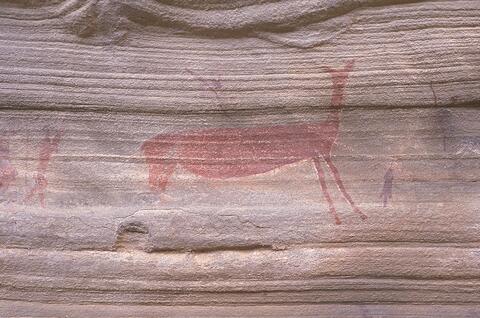Identity area
Reference code
Title
Date(s)
- 02/11/2000 (Creation)
Level of description
Extent and medium
Context area
Name of creator
Biographical history
Brief description of site: This rock shelter is a large 35 m cliff overhang with a smaller 7.7 m long and 2.2 m deep and low vestibule at the northern end. The shelter faces NW and is situated unusually high up with a commanding view over the adjacent Leeukloof and river. The sandstone's case-hardening has mostly weathered away, exposing the very soft heartrock beneath. The approach to the site is remarkable on account of the many ocular cavities that have eroded out of the rock. Some are large enough to be shelters and bear traces of archaeological artefacts.
There is a lot of dung overburden in the main shelter. In one section, however, an intact lens or organic material is visible. This lens consists mostly of grass and may represent the bedding material of the San who lived in the cave. In other areas there are ostrich eggshell fragments that would have been from water containers. There are also a few ostrich eggshell beads. Lithics (stone tools) are also present and are mainly of hornfels (lydianite) or crypto-crystalline silicates (chalcedonies or opalines). There are some hornfels endscrapers that were used to scrape and prepare hides for various leather goods such as karos, bags, clothing, thongs, shoes and so forth. There are also lots of chips and chunks that indicate stone tools were made on-site and that this was a major habitation site in the past. There are also artefacts present in some of the ocular cavities to the south.
Brief description of art: The rock-paintings are concentrated in a single 3.25 m x 0.58 m panel in the vestibule on the northern end, though the entire shelter must have at one stage been painted; though the case-hardening has now weathered away.
The RSA GNH1 rock-paintings number over 140 individual paintings that fall into two distinct types:
San or Bushman rock-paintings: Most of the paintings are San or Bushman and may be recognised by their fine, brush-applied outlines and infills. Painted in red, yellow, white and black paint and include depictions of over 35 eland (Tragelaphus oryx), vaal rhebuck (Pelea carolus) indeterminate antelope, human figures - some with spears - and some large animals. One human figure is exceptionally large at 310 mm; similarly, two of the eland exceed 400 mm in length. There is a rare rock-painting of a quagga (Equus quagga). Many of the 80+ human figures have bows and arrows while at least a dozen are depicted in postures associated with the Medicine or Trance Dance. There are also more curious human figures in a whitish-black pigment that bear clubs and may be representations of early Black farmers. There are two curious white bell-shaped motifs. There is also a cluster of 35 motifs that have been identified as aloes (see below), making these one of only three known San rock-paintings of plants.
Khoe (Khoi) rock-paintings: In contrast to the fine, brush-applied rock-paintings of the San, there are also Khoe rock-paintings in the shelter. There are the thicker motifs and stripes that have been applied with the finger. In the main shelter there are 15 black (once white) finger dots in a row. In the vestibule there are rows and isolated finger 'sausages' or stripes 70 mm - 110 mm long. There are also circle-like motifs and a motif that looks like a cross. These Khoe (Khoi) rock-paintings are painted on op of the San paintings and are thus younger in age.
The Aloe ferox Panel: There are 35 white and red rock-paintings of what Dr Ziets Zietsman, botanist at the National Museum, has identified as Aloe ferox. Aloe ferox is a plant endemic to the area. These paintings are exceptional, as this is only the third known San rock-painting in Lesotho and South Africa so far known. The other two examples are a Brunsviga at LES THB in Lesotho and aloes and lilliacea in the RSA GEN near Zastron. Though 70% of the San's diet consisted of plantfood, paintings of plants are exceedingly rare. Aloe ferox has a host of medicinal uses and the nectar is known to be narcotic.
Name of creator
Biographical history
Nationality: South African
Created by: willem
Created on: 11/03/2003
Name of creator
Biographical history
Repository
Archival history
Immediate source of acquisition or transfer
Content and structure area
Scope and content
Appraisal, destruction and scheduling
Accruals
System of arrangement
Conditions of access and use area
Conditions governing access
Conditions governing reproduction
Language of material
- English
Script of material
Language and script notes
Physical characteristics and technical requirements
Original size: 35mm

